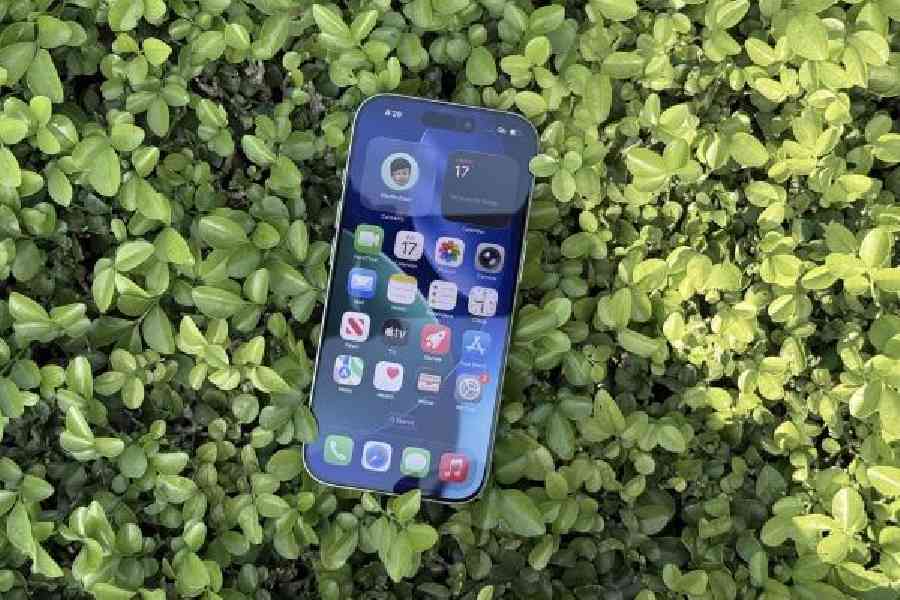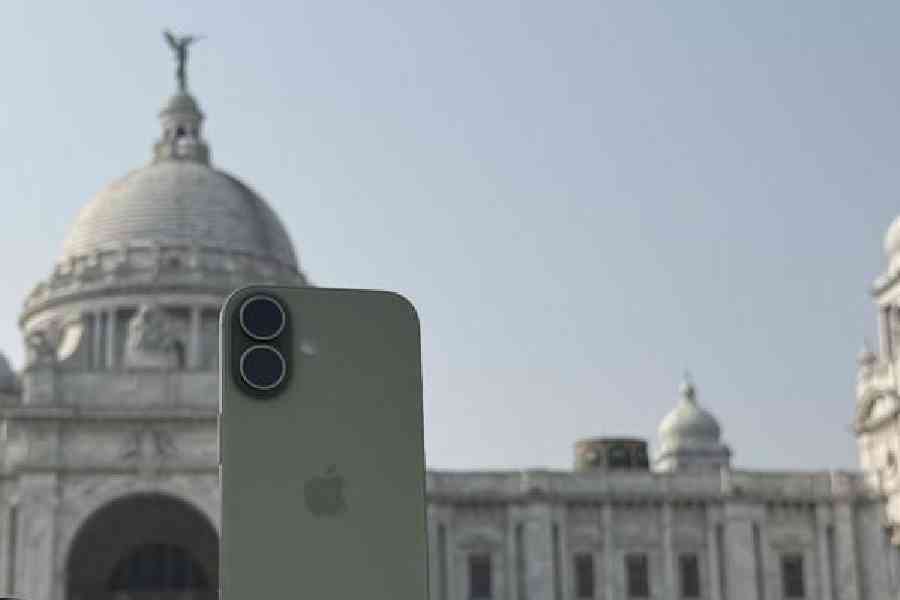Any company selling both a premium phone and a cheaper phone will do everything to ensure there is as little overlap as possible. And Apple has managed just that. With the new iPhone 17 series, the distinction between the base iPhone and the pro-grade model is clearer than ever before. It has become easier for customers to choose what works for them. iPhone 17 is the best base-level iPhone in many years.
An all-round package
The base model of every iPhone series has always been known for its playful colours, and the iPhone 17 is no exception. Made of striking aluminium and available in five rich shades, the fascination with the sage green option continues to grow; it’s among the best colours Apple has ever produced. One of the most elegant finishes from the company this year, it looks fantastic in every lighting condition.

A Diwali shopping moment captured in 2x mode in Calcutta's Burrabazar
There’s the Action Button, which can be mapped to different functions (personally, it’s set to Shazam for identifying music); Camera Control for easier navigation of camera tools; and Dynamic Island, which helps track real-time updates — whether it’s seeing how far your Swiggy delivery is or where your Uber currently is.
This year, we get a larger 6.3-inch panel with thinner borders. Apple has increased the display size without increasing the overall dimensions of the phone, making everything you do on this iPhone look even better. It’s something Apple did with last year’s Pro models, but it’s now here on the base iPhone.
The company is also offering Ceramic Shield 2 on the front, making it one of the most scratch-resistant devices in the market. Improving durability on the iPhone is a big deal, especially for those who prefer not to use cases or screen protectors. These seemingly small changes have significantly enhanced the overall design experience.
Pro-level display
The display has received one of the biggest upgrades in years. We’ve long been asking for a 120Hz ProMotion screen on the base model iPhone (can go down to as little as 1Hz for efficiency). The result is stunning — it makes everything run and feel incredibly smooth. No matter how powerful the chipset is, having a 120Hz display makes the phone feel buttery.
The update enables always-on display. There is also PWM or display pulse smoothing, which can create a smoother display output at low brightness levels. Animations, app launches, scrolling through menus, or even browsing Instagram or gaming — all look and feel flawless.
Another major change: Outdoor peak brightness has jumped from 2,000 to 3,000 nits. No matter how strong the sunlight, the display holds its own. The screen also has fewer reflections and twice the outdoor contrast. You’ll barely notice glare, and combined with ProMotion, the phone feels exceptionally smooth.
Rivals will copy this feature
Even though this is the base model, Apple hasn’t skimped on features like the front-facing camera, which now uses technology no other company offers. You get an 18MP Centre Stage front camera, for which Apple has moved from a vertical to a square sensor.
Apple is using a massive 24MP square selfie camera but the photos you take will be 18MP horizontal crop or an 18MP vertical crop. It allows you to shoot horizontal images while holding your iPhone vertically. A big issue Apple noticed was that when people took selfies in landscape mode, they often looked at the display instead of the camera. Now, since you can shoot vertically and still get horizontal photos, that problem disappears.

The iPhone 17 finally has an always-on display
There’s more. With Centre Stage, subjects remain in frame automatically. If a second person joins, the camera adjusts focus; if a third joins, it zooms out slightly to accommodate them — all automatically.
The square sensor also enables you to capture horizontal videos while holding the phone vertically. You can toggle between auto zoom and auto rotate, and the camera widens the shot whenever it detects more people.
And here’s a personal favourite: Selfies can now get even wider. Shooting selfies with the ultra-wide lens is trendy — and the results are excellent.
Since there is more sensor around outside of the frame you are using, the extra information is used for better stabilisation. Even without Action Mode or special settings, the output is smoother and more stable.
Two points of view
Continuing with the front camera, another fun addition this year is Dual Capture. It allows users to record both the front and rear views simultaneously — essentially letting you film your reaction while capturing what you’re seeing. Previously, this was only possible through specific third-party apps, often paid ones.
It’s ideal if you’re teaching something, attending a concert, recording a baby’s first steps, or documenting a special moment — you can capture both perspectives at once. You can also move your view to any corner of the screen.
Do note, however, that once you record using Dual Capture, you can’t reposition or remove your own layer in editing.
Camera king
The main cameras have also been upgraded. The primary wide camera remains a 48MP Fusion sensor with a 2x optical telephoto lens, but Apple has improved resolution and processing.

iPhone 17’s main camera has a 48MP resolution
The biggest leap, however, is with the ultra-wide lens, which now boasts 48MP resolution and a larger, higher-quality sensor that delivers sharper images and better low-light performance.
The iPhone remains the gold standard for video. The iPhone 17 supports 4K at 60 frames per second, includes Action Mode for stabilisation, wind-noise reduction powered by machine learning, and an Audio Mix feature that lets you edit sound after shooting — one of the best implementations on any smartphone.
The base iPhone 17 has two lenses that cover most use cases. For dramatic 8x telephoto shots, you’ll need the iPhone 17 Pro. The 0.5x lens allows for extreme wide-angle and macro photography — ideal for close-ups of insects or flowers — while the main wide camera handles everyday shots. You can zoom up to 2x without losing resolution, and up to 10x digitally.
Apple’s image processing remains subtle, maintaining a natural tone. For more flair, you can use Photographic Styles introduced in earlier models.
Smooth operator
Performance has always been an iPhone hallmark, and this year is no different. At the heart of the iPhone 17 lies the A19 chip, featuring a six-core CPU (two performance and four efficiency cores), a five-core GPU with Neural Accelerators, a 16-core Neural Engine, and hardware-accelerated ray tracing. It’s one of the most powerful single-core chips at the moment that offers future-proofing.
The icing on the cake: Apple has doubled the base level storage from 128GB to 256GB, which is where all the price comparison starts coming in. Now every model of the iPhone feels cheaper because of the upgrade.
This powers Apple Intelligence features while improving efficiency. Battery life is outstanding — Apple has added extra hours of video playback compared to the iPhone 16. With the ability to drop refresh rate to 1Hz for always-on display or for thumbing through photographs, you can save a lot of battery. It’s a meaningful longer battery life.
The iPhone 17 includes every essential specification and feature expected of an iPhone. Apple Intelligence works smoothly, with many new capabilities — like the revamped Siri — arriving soon.
Make the call
Many users will be upgrading from an iPhone 11 or even an iPhone 15. With Apple Intelligence becoming more advanced and demanding on chipsets, this is a smart time to upgrade.
Issues? The Dual Capture mode can get better if both simultaneous video feeds can be separated. Or at least allow the front feed video to be moved around the screen even after recording. These features can be fixed with a simple software update.
As AI becomes more powerful, you’ll want a processor capable of keeping up. The iPhone 17 strikes a perfect balance — you get most of the Pro’s features without the premium price tag.
For 70 per cent of users, the iPhone 17 is the best choice. It’s a flagship that doesn’t break the bank. iPhone 17 is simply a brilliant package with enough headroom for updates. It can become the durable default phone for most people.
When a base phone in a lineup improves, two things happen. First, the pro-level options become that much better, which has happened with iPhone 17 Pro. Second, more people from Android become interested in iPhones. And that’s a win.











